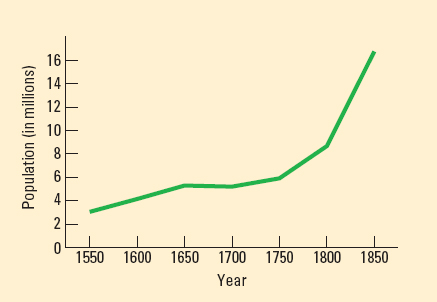Long-Standing Obstacles to Population Growth
Until 1700, the total population of Europe grew slowly much of the time, and it followed an irregular cyclical pattern (Figure 17.1). This cyclical pattern had a great influence on many aspects of social and economic life. The terrible ravages of the Black Death of 1348–
By the mid-

 The Growth of Population in England, 1550–
The Growth of Population in England, 1550–Births and deaths, fertility and mortality, were in a crude but effective balance. The population grew modestly in normal years at a rate of perhaps 0.5 to 1 percent. Although population growth of even 1 percent per year seems fairly modest, it will produce a very large increase over a long period: in three hundred years it will result in sixteen times as many people. Yet such significant increases did not occur in agrarian Europe. In certain abnormal years and tragic periods — the Black Death was only the most extreme example — many more people died than were born, and total population fell sharply, even catastrophically. A number of years of modest growth would then be necessary to make up for those who had died in an abnormal year. Such savage increases in deaths occurred periodically in the seventeenth century on a local and regional scale, and these demographic crises combined to check the growth of population until after 1700.
The grim reapers of demographic crisis were famine, epidemic disease, and war. Episodes of famine were inevitable in all eras of premodern Europe, given low crop yields and unpredictable climatic conditions. In the seventeenth century, much of Europe experienced unusually cold and wet weather, which produced even more severe harvest failures and food shortages than usual. Contagious diseases also continued to ravage Europe’s population on a periodic basis. War was another scourge, and its indirect effects were even more harmful than the purposeful killing during military campaigns. Soldiers and camp followers passed all manner of contagious diseases throughout the countryside. Armies requisitioned scarce food supplies and disrupted the agricultural cycle, while battles destroyed precious crops, livestock, and farmlands.